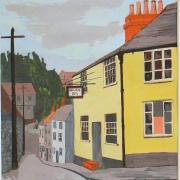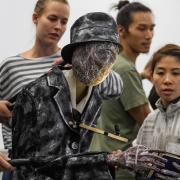January marks the 125th birthday of J. R. R. Tolkien who created the mythical world of Middle-earth. Jeremy Miles reveals how this literary superstar escaped unwanted fame on the Bournemouth coast
‘Never trust a hippy’ is a phrase that has gone down in social history as the 1970s clarion call of the punk movement. However it could just as well have been coined more than a decade earlier by the tweedy and sometimes rather irritable figure of John Ronald Reuel Tolkien.
The academic and fantasy author loathed the long-haired flower children who had started turning up on his doorstep in Oxford. They would arrive smelling of patchouli oil and incense, clutching copies of The Hobbit and The Lord of the Rings.
The lofty minded JRR - an expert in Anglo Saxon history who could speak thousand year old languages and debate their syntax and morphology for hours - had little to say to them. He was the product of a completely different world. A classically educated scholar and the son of a British banking executive, Tolkien was born on 3rd January 1892 in colonial South Africa. He was so unsettled by the attentions of his new fans that, in 1968, he and his wife Edith decided to move to Bournemouth.
The Tolkiens had been holidaying in Dorset for years. JRR had once been a frequent visitor to Lyme Regis, but during the 1950s and 60s their regular summer destination had been Bournemouth’s Hotel Miramar. A fine arts and crafts style Edwardian building that had once been the home of the Austrian Ambassador, The Miramar provided a solidly respectable country house style retreat on the town’s East Cliff.
Today the hotel celebrates its Tolkien connections with a blue plaque and has knocked together the adjoining rooms that the couple used to occupy. There’s even a faded old photograph of J. R. R. Tolkien relaxing on the terrace and a signed map of Middle-earth.
It is a popular and lively four star establishment but back in the 1950s and 60s it was really rather dull and, if truth be told, Tolkien found the chatter of the society wives and crusty retired colonels decidedly tedious. He felt rather lost amid the gentle rattle of teacups and nibbling of cucumber sandwiches. He longed for the stimulating conversations he enjoyed with fellow academics like his friend C.S. Lewis.
Despite his near addiction to the donnish world of Oxford, Tolkien knew only too well that Edith loved Bournemouth with a passion and it was for her, as well as the need to get away from the unwanted attentions of the fantasy fiction merchants who had contrived to make him trendy, that JRR reluctantly agreed to up-sticks and retire permanently to the Dorset coast.
He was completely nonplussed by the knock-on effect of the late fame of his books. He’d initially written The Hobbit mainly for his children while its sequel The Lord of the Rings trilogy was a natural development of the story. He could never have anticipated that his fantasies about the mythical world of Middle-earth with its elves, dwarves and wizards would bring him a cult following.
By the 1960s J. R. R. Tolkien was a world renowned best-selling author. He had no problem with that. He was comfortable, financially secure and required nothing more. The idea that he would eventually go on to become the world’s second best selling author of fiction, closely behind Charles Dickens, would have astounded him.
The concept of celebrity was beyond Tolkien’s comprehension and he neither understood nor had any wish to engage with popular culture. At one point even The Beatles had approached him asking for permission to make, and star, in a Lord of the Rings feature film.
Tolkien, who had no time for beat groups, was horrified and turned the idea down flat. Had the deal come off, the rumour was that the Fab Four had planned to ask Stanley Kubrick to direct with John Lennon playing Gollum, Paul McCartney as Frodo, Ringo Starr as Sam and George Harrison as Gandalf.
One wonders what would have emerged and the music it might have inspired. One also wonders what Tolkien would have made of the massive posthumous fame afforded by Peter Jackson’s blockbuster Lord of the Rings and Hobbit movies. I suspect he would have been equally horrified even though he himself had sold the film rights to United Artists in 1969 for £100,000. It was a transaction that the gleeful movie moguls later dubbed Hollywood’s deal of the century. The agreement was sealed right here in Dorset. It is said that JRR signed the rights over one afternoon while Edith was at the Miramar playing cards with friends. The subsequent success of the films 40 long years later would elevate Tolkien to the position of fifth highest earning dead celebrity, right up there with Elvis. How bizarre is that?
His son, Christopher Tolkien, was singularly unimpressed with the movie treatment. In 2012 he told the French newspaper Le Monde that Jackson’s Lord of the Rings had seen his father’s work “devoured by its own popularity and absorbed into the absurdity of our time.” He added: “The commercialisation has reduced the aesthetic and philosophical impact of the creation to nothing.”
Escaping to Dorset back in 1968 the Tolkien’s had settled on a comfortable but rather nondescript bungalow in Lakeside Drive, Branksome Park, just over the border from Bournemouth in Poole. Unwanted fame had already drawn barbed commentary on their chosen lifestyle. In 1966 they had been alarmed by comments made by W. H. Auden, who had rather bitchily told the Tolkien Society of America: ‘He lives in a hideous house – I cannot tell you how hideous…’
Now attention was turned to their new home in Poole. Society photographer Lord Snowdon - the Queen’s brother-in-law no less, visited in the early 1970s. He took a famous portrait of Tolkien sitting amid a tangle of tree roots on the pine-clad chine not far from the bungalow. It seems it was as Middle-earth as he could find. Later, when the image was published in 1979 in a lavish coffee table book Snowden, dismissed the Tolkien’s bungalow as “curiously characterless.”
By that time, mercifully perhaps, both Tolkiens were dead. Edith who had been in poor health for several years, died in1971 prompting JRR to return to Oxford.
However he made frequent visits to Bournemouth both to the Miramar and to see his friend and one-time physician Dr Denis Tolhurst. While staying with Tolhurst and his wife Jocelyn at their home in Meyrick Park in August 1973, Tolkien collapsed and was rushed hospital with a bleeding gastric ulcer. Surgery initially seemed successful but complications set in and he died on 2nd September aged 81.
Eventually in 2006 the Lakeside Drive house, which Tolkien had sold 35 years earlier for £23,000, went on the market again with a £1million price tag. It was bought by a developer who built two eco-friendly homes on the site.
But the Tolkien effect continues to work its magic. The books, films and other spin-offs have generated billions and everyone wants a piece of the action. Just four years ago an Adam-style fireplace retrieved from the bungalow by the demolition team sold for more than £50,000. While earlier this year a signed first edition of The Hobbit fetched an eye-watering £137,000.
Tolkien was a successful and wealthy man but had anyone suggested that his eventual posthumous worth would be counted in billions I am certain he would have dismissed it as fantasy.
More…
• Multi millionaire retailer Mr Selfridge’s secret Dorset life - Harry Gordon Selfridge spoiled women in his personal life the same way he did the female customers in his department store. But his love of dance girls, his ostentacious plans and lavish spending in Dorset heralded the start of his sad demise into penury



























